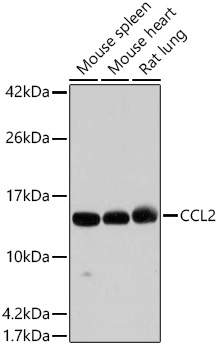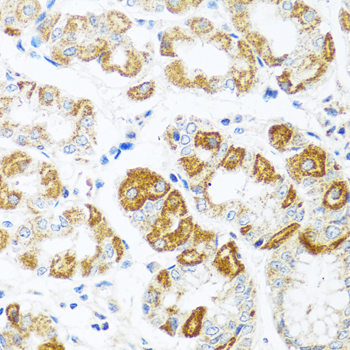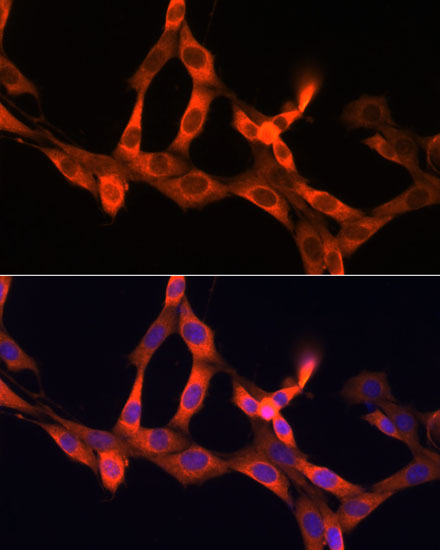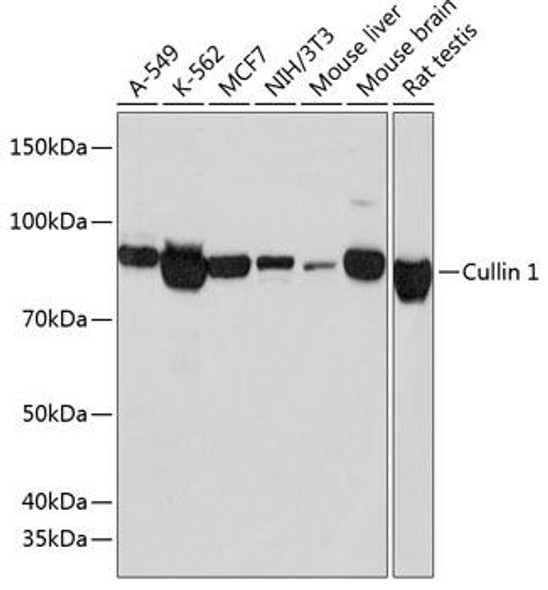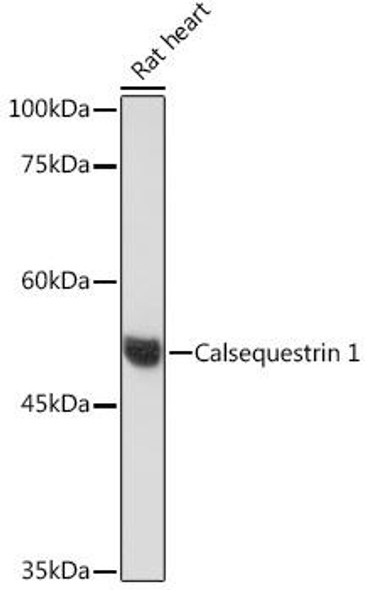Anti-MCP-1 Antibody (CAB7277)
- SKU:
- CAB7277
- Product type:
- Antibody
- Reactivity:
- Human
- Mouse
- Rat
- Host Species:
- Rabbit
- Isotype:
- IgG
- Antibody Type:
- Polyclonal Antibody
- Research Area:
- Cell Biology
Description
| Antibody Name: | Anti-MCP-1 Antibody |
| Antibody SKU: | CAB7277 |
| Antibody Size: | 20uL, 50uL, 100uL |
| Application: | WB IHC IF |
| Reactivity: | Human, Mouse, Rat |
| Host Species: | Rabbit |
| Immunogen: | Recombinant fusion protein containing a sequence corresponding to amino acids 24-99 of human MCP-1 (NP_002973.1). |
| Application: | WB IHC IF |
| Recommended Dilution: | WB 1:500 - 1:2000 IHC 1:100 - 1:200 IF 1:50 - 1:100 |
| Reactivity: | Human, Mouse, Rat |
| Positive Samples: | Mouse spleen, Mouse heart, Rat lung |
| Immunogen: | Recombinant fusion protein containing a sequence corresponding to amino acids 24-99 of human MCP-1 (NP_002973.1). |
| Purification Method: | Affinity purification |
| Storage Buffer: | Store at -20°C. Avoid freeze / thaw cycles. Buffer: PBS with 0.02% sodium azide, 50% glycerol, pH7.3. |
| Isotype: | IgG |
| Sequence: | QPDA INAP VTCC YNFT NRKI SVQR LASY RRIT SSKC PKEA VIFK TIVA KEIC ADPK QKWV QDSM DHLD KQTQ TPKT |
| Gene ID: | 6347 |
| Uniprot: | P13500 |
| Cellular Location: | Secreted |
| Calculated MW: | 11kDa |
| Observed MW: | 11kDa |
| Synonyms: | CCL2, GDCF-2, HC11, HSMCR30, MCAF, MCP-1, MCP1, SCYA2, SMC-CF |
| Background: | This gene is one of several cytokine genes clustered on the q-arm of chromosome 17. Chemokines are a superfamily of secreted proteins involved in immunoregulatory and inflammatory processes. The superfamily is divided into four subfamilies based on the arrangement of N-terminal cysteine residues of the mature peptide. This chemokine is a member of the CC subfamily which is characterized by two adjacent cysteine residues. This cytokine displays chemotactic activity for monocytes and basophils but not for neutrophils or eosinophils. It has been implicated in the pathogenesis of diseases characterized by monocytic infiltrates, like psoriasis, rheumatoid arthritis and atherosclerosis. It binds to chemokine receptors CCR2 and CCR4. |
| UniProt Protein Function: | CCL2: Chemotactic factor that attracts monocytes and basophils but not neutrophils or eosinophils. Augments monocyte anti-tumor activity. Has been implicated in the pathogenesis of diseases characterized by monocytic infiltrates, like psoriasis, rheumatoid arthritis or atherosclerosis. May be involved in the recruitment of monocytes into the arterial wall during the disease process of atherosclerosis. Monomer or homodimer; in equilibrium. Binds to CCR2 and CCR4. Is tethered on endothelial cells by glycosaminoglycan (GAG) side chains of proteoglycans. Belongs to the intercrine beta (chemokine CC) family. |
| UniProt Protein Details: | Protein type:Secreted; Chemokine; Secreted, signal peptide; Motility/polarity/chemotaxis Chromosomal Location of Human Ortholog: 17q11.2-q12 Cellular Component: extracellular space; rough endoplasmic reticulum; perinuclear region of cytoplasm; endocytic vesicle; dendrite; extracellular region; synapse; perikaryon; nerve terminal Molecular Function:heparin binding; chemokine activity; CCR2 chemokine receptor binding; receptor binding; protein kinase activity Biological Process: maternal process involved in pregnancy; protein amino acid phosphorylation; response to antibiotic; monocyte chemotaxis; regulation of cell shape; cell surface receptor linked signal transduction; response to vitamin B3; transforming growth factor beta receptor signaling pathway; negative regulation of neuron apoptosis; cellular homeostasis; cell adhesion; neutrophil chemotaxis; organ regeneration; response to amino acid stimulus; JAK-STAT cascade; positive regulation of tumor necrosis factor production; G-protein signaling, coupled to cyclic nucleotide second messenger; organ morphogenesis; unfolded protein response, activation of signaling protein activity; response to ethanol; cellular response to insulin stimulus; response to bacterium; response to heat; response to mechanical stimulus; positive regulation of endothelial cell proliferation; response to activity; response to progesterone stimulus; positive regulation of nitric-oxide synthase biosynthetic process; positive regulation of collagen biosynthetic process; signal transduction; chemotaxis; positive regulation of synaptic transmission; positive regulation of cellular extravasation; protein kinase B signaling cascade; response to wounding; lipopolysaccharide-mediated signaling pathway; response to gamma radiation; angiogenesis; inflammatory response; lymphocyte chemotaxis; aging; unfolded protein response; cytokine and chemokine mediated signaling pathway; MAPKKK cascade; cytoskeleton organization and biogenesis; viral genome replication; macrophage chemotaxis; humoral immune response; leukocyte migration during inflammatory response; cellular calcium ion homeostasis; G-protein coupled receptor protein signaling pathway; negative regulation of angiogenesis; positive regulation of leukocyte mediated cytotoxicity; cellular protein metabolic process; maternal process involved in parturition; response to hypoxia; positive regulation of T cell activation; vascular endothelial growth factor receptor signaling pathway; astrocyte cell migration Disease: Neural Tube Defects; Mycobacterium Tuberculosis, Susceptibility To; Human Immunodeficiency Virus Type 1, Susceptibility To |
| NCBI Summary: | This gene is one of several cytokine genes clustered on the q-arm of chromosome 17. Chemokines are a superfamily of secreted proteins involved in immunoregulatory and inflammatory processes. The superfamily is divided into four subfamilies based on the arrangement of N-terminal cysteine residues of the mature peptide. This chemokine is a member of the CC subfamily which is characterized by two adjacent cysteine residues. This cytokine displays chemotactic activity for monocytes and basophils but not for neutrophils or eosinophils. It has been implicated in the pathogenesis of diseases characterized by monocytic infiltrates, like psoriasis, rheumatoid arthritis and atherosclerosis. It binds to chemokine receptors CCR2 and CCR4. [provided by RefSeq, Jul 2013] |
| UniProt Code: | P13500 |
| NCBI GenInfo Identifier: | 126842 |
| NCBI Gene ID: | 6347 |
| NCBI Accession: | P13500.1 |
| UniProt Secondary Accession: | P13500,Q9UDF3, B2R4V3, |
| UniProt Related Accession: | P13500 |
| Molecular Weight: | 11,025 Da |
| NCBI Full Name: | C-C motif chemokine 2 |
| NCBI Synonym Full Names: | chemokine (C-C motif) ligand 2 |
| NCBI Official Symbol: | CCL2 |
| NCBI Official Synonym Symbols: | HC11; MCAF; MCP1; MCP-1; SCYA2; GDCF-2; SMC-CF; HSMCR30 |
| NCBI Protein Information: | C-C motif chemokine 2; small-inducible cytokine A2; monocyte secretory protein JE; monocyte chemotactic protein 1; monocyte chemoattractant protein 1; monocyte chemoattractant protein-1; monocyte chemotactic and activating factor; small inducible cytokine subfamily A (Cys-Cys), member 2; small inducible cytokine A2 (monocyte chemotactic protein 1, homologous to mouse Sig-je) |
| UniProt Protein Name: | C-C motif chemokine 2 |
| UniProt Synonym Protein Names: | HC11; Monocyte chemoattractant protein 1; Monocyte chemotactic and activating factor; MCAF; Monocyte chemotactic protein 1; MCP-1; Monocyte secretory protein JE; Small-inducible cytokine A2 |
| Protein Family: | C-C motif chemokine |
| UniProt Gene Name: | CCL2 |
| UniProt Entry Name: | CCL2_HUMAN |


